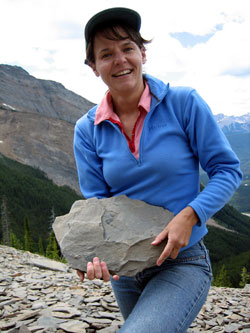About the topic
Bio
Get the Flyer (pdf)
About the topic
Mammals living above the Arctic Circle 53 million years ago endured six months of darkness each year—but in a far milder climate than today, according to a new study by the University of Colorado at Boulder. The findings hint to how modern mammals might migrate if the global climate continues to warm.
Jaelyn Eberle, CU-Boulder associate professor of geological sciences, says her study shows several varieties of prehistoric mammals as heavy as 1,000 pounds each lived on what is today Ellesmere Island near Greenland on a summer diet of flowering plants, deciduous leaves, and aquatic vegetation. But in winter’s twilight they apparently switched over to foods like twigs, leaf litter, evergreen needles, and fungi, explains Eberle, curator of fossil vertebrates at the University of Colorado Museum of Natural History and chief study author.
The study has implications for the dispersal of early mammals across polar land bridges into North America and for modern mammals that likely will begin moving north if Earth’s climate continues to warm. A paper on the subject coauthored by Henry Fricke of Colorado College in Colorado Springs and John Humphrey of the Colorado School of Mines in Golden, and other colleagues, appears in the June issue of Earth and Planetary Science Letters.
The team used an analysis of carbon and oxygen isotopes extracted from the fossil teeth of three varieties of mammals from Ellesmere Island—a hippo-like, semi-aquatic creature known as Coryphodon, a second, smaller ancestor of today’s tapirs, and a third rhino-like mammal known as brontothere. Animal teeth are among the most valuable fossils in the high Arctic because they are extremely hard and better able to survive the harsh freeze-thaw cycles that occur each year, Eberle notes.
“We were able to use carbon signatures preserved in the tooth enamel to show that these mammals did not migrate or hibernate,” adds Eberle. “Instead, they lived in the high Arctic all year long, munching on some unusual things during the dark winter months.”
An analysis of oxygen isotopes from the fossil teeth helped determine seasonal changes in surface drinking water tied to precipitation and temperature, providing additional climate information, says Eberle. The results point to warm, humid summers and mild winters in the high Arctic 53 million years ago, where temperatures probably ranged from just above freezing to near 70 degrees Fahrenheit (21 C).
The environment on central Ellesmere Island, located at about 80 degrees north latitude, was part of a much larger circumpolar Arctic region at the time. It probably was similar to swampy cypress forests in the southeast United States today and still contains fossil tree stumps as large as washing machines, Eberle adds.
The year-round presence of mammals in the high Arctic was a “behavioral prerequisite” for their eventual dispersal across high-latitude land bridges that geologists believe linked Asia and Europe with North America, Eberle explains. Their dietary chemical signatures, portly shapes, and fossil evidence for babies and juveniles in the Arctic preclude the idea of long, seasonal migrations to escape the winter darkness.
“In order for mammals to have covered the great distances across land bridges that once connected the continents, they would have required the ability to inhabit the High Arctic year-round in proximity to these land bridges,” Eberle notes.
Instead, the animals likely made their way south from the Arctic in minute increments over millions of years as the climate shifted. “This study may provide the behavioral smoking gun for how modern groups of mammals like ungulates—ancestors of today’s horses and cattle—and true primates arrived in North America,” says Eberle.
The new study also foreshadows the impacts of continuing global warming on Arctic plants and animals, Eberle adds. Temperatures in the Arctic are rising twice as fast as those at mid-latitudes as greenhouse gases build up in Earth’s atmosphere from rising fossil-fuel burning, and air temperatures over Greenland have risen by more than 7 degrees F since 1991, according to climate scientists.
“We are hypothesizing that lower-latitude mammals will migrate north as the temperatures warm in the coming centuries and millennia,” she adds. “If temperatures ever warm enough in the future to rival the Eocene, there is the possibility of new intercontinental migrations by mammals.”
Because the oldest known tapir fossils are from the Arctic, there is the possibility that some prehistoric mammals could have evolved in the circumpolar Arctic and then dispersed through Asia, Europe, and North America. “We may have to rethink the world of the early Eocene, when all of the Arctic land masses were connected in a supercontinent of sorts,” she says.
Bio
 Jaelyn J. Eberle grew up on a grain farm in Saskatchewan, and she decided that she wanted to be a paleontologist at the ripe old age of 5! Jaelyn graduated with Distinction in 1991 from the Bachelor of Science Honours program in Palaeobiology at the University of Saskatchewan in Saskatoon. She went on to earn a Ph.D. in Geology from the University of Wyoming in 1996. She is now Curator of Vertebrate Paleontology at the University of Colorado Museum of Natural History (UCM) and assistant professor in Geological Sciences at the University of Colorado at Boulder.
Jaelyn J. Eberle grew up on a grain farm in Saskatchewan, and she decided that she wanted to be a paleontologist at the ripe old age of 5! Jaelyn graduated with Distinction in 1991 from the Bachelor of Science Honours program in Palaeobiology at the University of Saskatchewan in Saskatoon. She went on to earn a Ph.D. in Geology from the University of Wyoming in 1996. She is now Curator of Vertebrate Paleontology at the University of Colorado Museum of Natural History (UCM) and assistant professor in Geological Sciences at the University of Colorado at Boulder.
Her research focuses on mammalian evolution across the Cretaceous-Tertiary boundary (that infamous K-T boundary when dinosaurs went extinct); and High Arctic vertebrate evolution, paleoclimate, and paleogeography during the Eocene (some 50-55 million years ago). Jaelyn has active field programs in the Rocky Mountain region and the Canadian High Arctic. She specializes in the study of fossil mammals from late Cretaceous and Paleogene time, particularly their evolution, phylogeny, paleobiogeography and paleoecology. Her field research stretches from the Colorado Rockies to Canada’s High Arctic.
During her career as a palaeontologist she has received the Romer Prize, the highest honour the Society of Vertebrate Paleontology awards to graduate students. She discovered the northernmost record of fossil mammals in the world and the first and only known fossil vertebrates from the Geodetic Hills mummified fossil forest on Axel Heiberg Island in the Canadian High Arctic. Jaelyn also participated in the Denver Basin Project and has gone on to co-author books, lecture at Rice University in Houston, Texas, and be a research scientists in Paleontology at the Canadian Museum of Nature. In addition, she has received more than twenty research grants and awards from various palaeontological societies.
Jaelyn lives with her husband David (a geologist and exploration manager with Noble Energy) and their three sons Nicholas, Quinlan, and William in Broomfield, Colorado.
